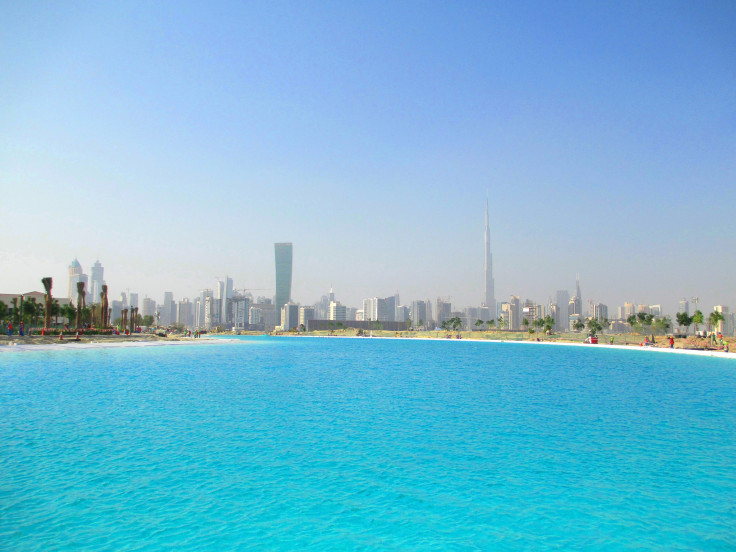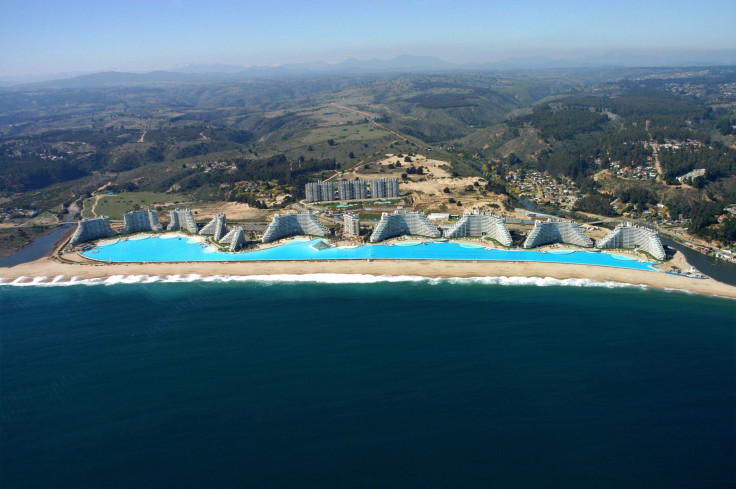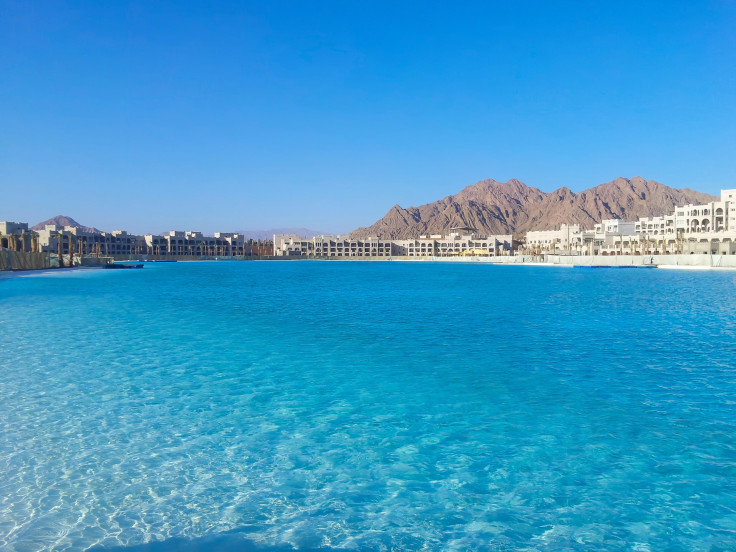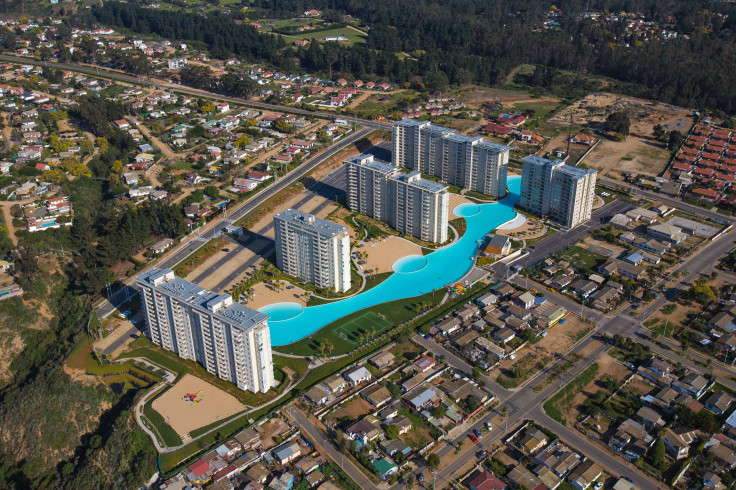In Dubai, A 90-Acre Swimming Pool Is The Next Big Thing In Real Estate Development

In Dubai, the unwritten rule is: If it doesn’t exist in its natural form, dig, scrape or shape it until you have an amusement park-style copycat of -- or improvement on -- the real thing.
Soon, that rule will apply to a large manmade lagoon that has the same clarity as a swimming pool: In other words, a lake that nature might have formed if it had a board of directors.
As Dubai has made the leap from desert backwater to glittering metropolis, the Persian Gulf emirate has accrued some of the most prodigious and over-the-top works of modern engineering on Earth. To lure outsiders to a seemingly uninhabitable swath of Arabian sand required creating desirable amenities from scratch, including comfortable climates, on a micro scale. Along the way, Dubai has elevated the concept of the artificial environment to a new level.
There have been complications in this remastering of nature, including staggering energy shortages and tourists swimming amid raw sewage, but Dubai remains undaunted in its quest to become one of the world’s most cutting-edge luxury destinations.
The city’s latest venture is a colossal, artificial lagoon, fed from brackish groundwater, that stretches across nearly 90 acres of desert. The huge water feature, which has a surface area equivalent to some 330 Olympic swimming pools, is the mainstay of a $7.1 billion development project in Mohammed Bin Rashid City, in the heart of Dubai, and, when complete, will be the largest manmade lagoon of its kind in the world. The first phase has been completed, and the full 90-acre project is expected to be done by 2020.
The company behind Dubai’s latest indulgence is Chile-based Crystal Lagoons, whose artificial lagoons have cropped up across Latin America and the Middle East and have just begun to make their way into the U.S. market. The concept is that beachfront property can be created that includes the uncomplicated comfort of a massive swimming pool -- but with fewer chemical additives, on a scale that enables residents and tourists to enjoy water sports like kayaking and even sailing.

Not surprisingly, developers say the revenue potential is huge; promoting their projects is part of their job. But others in the industry say such carefully regulated manmade water features do hold the potential to be the next big thing in residential development, much as golf courses once were.
“Developers are getting more sophisticated in how to deploy this as a business tool,” Kevin Morgan, chief executive of Crystal Lagoons’ U.S. subsidiary, Crystal Lagoons USA Inc., told International Business Times.
Crystal Lagoons’ enormous water projects have made headlines before for their dramatic appearance. Since it completed its first large lagoon project in Chile 17 years ago, Crystal Lagoons has worked on dozens of similar projects and has hundreds more in various stages of development, including one for a planned community in Florida called Tradition Florida where groundwater will be used to fill the lagoon. The latest Crystal Lagoon opened this year at a resort in Cabo San Lucas, Mexico.
What it comes down to is “location, location, location,” Jennifer Languell, who owns Fort Myers, Florida-based Trifecta Construction Solutions, which does green and sustainable consulting work, told IBTimes. “You have to have an amenity that attracts people. This type of amenity is so unique.”
Languell added that Crystal Lagoons “seems to have found an interesting niche, especially in the Middle East, where they don’t have the beaches like we have.”
Morgan said Crystal Lagoons has completed more than 50 projects around the world, varying in size from a few acres to upwards of 30 acres. Its largest lagoon, before Dubai’s is completed, is in Egypt.

While some developers are doubtful of the lagoons’ ability to spur economic growth, others say they have the potential to draw clients to plots of land that would have otherwise remained undeveloped.
“It’s the same approach that was used back with golf courses,” said John Gerner, managing director of Leisure Business Advisors LLC in Richmond, Virginia. “Because they’re very scenic and unusual, you can use them as a selling tool.” Instead of green fairways, such developments offer crystal-clear water to an otherwise dry landscape, and, according to Gerner, people will pay a premium to live near a state-of-the-art water feature.
Golf courses, once a major draw for homeowners and developers to remote suburbs, are no longer the gold standard, as they were 20 years ago. In the U.S., because of the high costs of maintaining hundred-plus-acre golf courses, many are being chopped up and sold in pieces to luxury home builders.
“Water has a broader appeal than almost anything,” John Rymer, president of Rymer Strategies Real Estate Advisors in Tampa, Florida, told IBTimes. “What I think [Crystal Lagoons] has tapped into is the need to supercharge that water amenity and make it more desirable than just a standard lake.”
In other words, such lagoons are not simply large impoundments of water that can become muddy or otherwise unattractive to swimmers.
Thanks to talk of a Crystal Lagoon, Rymer said, some Florida developers are considering locations further from the beach that they might not have looked twice at before.
Morgan says the costs of these projects vary based on location and topography, but that the average cost per acre of Crystal Lagoons technology is between $200,000 and $300,000 USD. He said maintaining a Crystal Lagoon pond is cheaper than keeping up a golf course.

Part of the low cost, he said, involves the company’s technology, which uses ultrasound to move all the sediments (and any accumulated trash) in the lagoons to the center, where they can be easily retrieved by mechanical means. The lagoons are monitored remotely from a single location and any needed changes in water composition can be made via remote telemetry, reducing the cost of having staff on the ground.
Whether people will flock to relatively sterile yet pretty lagoons remains to be seen. And there are environmental considerations, particularly in places like Florida where flooding or filling wetlands is closely regulated.
“It’s all how you manage the surrounding land that will determine the environmental burden,” Languell said. But, she said,“sustainability has to have an economic component.”
In Dubai, a manmade lagoon won’t likely have many detractors, and developers say it’s a safe bet that people will be attracted to a clean, clear lagoon in the otherwise urbanized and arid environment.
© Copyright IBTimes 2025. All rights reserved.






















